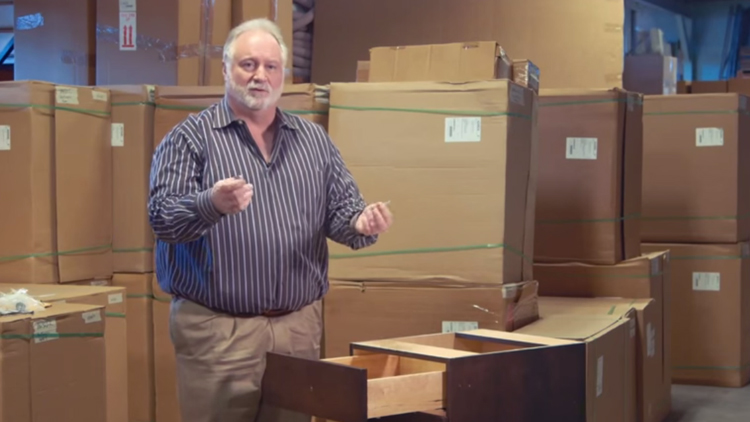Sponsored Content Brought To You By Alure Home Improvements
Changing the hardware on cabinets is easier than you might think, as Doug Cornwell, the chief operating officer of Alure Home Improvements, demonstrates in the latest installment of “Alure’s 60 Second Fix: How To Replace Your Cabinet Hardware In 60 Seconds.”
He’ll show you how simple the task can be, but have you ever thought of where these knobs and drawer pulls came from? We’ll get into that, too.
First, let’s focus on replacing knobs and pulls.
As Cornwell points out, common cabinet hardware basically comes in two types. Knobs have single screw holes and pulls have two holes.
Replacing a knob on a cabinet door or a drawer just entails unscrewing the knob, and poking the screw back through the hole with your finger. Cornwell holds his other hand inside the drawer, ready to catch the screw in his open palm for convenience sake.
Once the unwanted knob is gone, you just repeat the procedure in reverse. Be sure to tighten up the knob so it doesn’t come loose because this knob will get a lot of use if it’s on a kitchen cabinet or a kitchen drawer.
Now, pulls are “a little more difficult” to replace, as Cornwell says. Because they come with two holes, you want to make sure that the replacement pull has its pair of holes the same distance apart as the ones on the original pull.
“You want it to match up,” says Cornwell.
So, he advises that you take the existing pull with you when you go to the hardware store, and make sure the new pull’s holes line up exactly before you make your purchase. It’s common sense. Why screw around when life is complicated enough!
Once you’re satisfied with your new hardware, just hold the pull on the outside of the cabinet door or the drawer, insert the screws from the inside pointing out, and tighten them up accordingly. Then you can move on to the next one. Or make yourself a drink and relax because your job is done.
In this example, Cornwell is talking about the fixtures most commonly found in kitchen cabinetry, but his advice could apply to cabinets and drawers anywhere in your house, such as bedroom dressers, bureaus or chiffoniers. Some homeowners have a profusion of cabinets with an array of interesting knobs and pulls on display. But people in some parts of the world, even today, have never had a cabinet in their lives.
Historians say that knobs evolved as furniture became more available to broader classes of people beyond the nobility and the aristocracy. Rugged durability was their requirement, especially if the furniture owners were on the move. According to Whitechapel Ltd., the knob became a more acceptable exposed fitting on fine furniture in the 19th century after well-known English cabinet makers, Thomas Chippendale, George Hepplewhite and Thomas Sheraton had introduced large decorated face brass knobs in the late 18th century. Then the technology had advanced to make them more ubiquitous and less expensive to produce. In keeping with their guiding principles of honesty, utility and simplicity in their craftsmanship, the Shakers used simple turned-wood knobs instead of imported brass drawer pulls as they constructed their own household furnishings at their experimental communes in America. As they put it, veneering and applied ornamentation were “deceitful” practices, according to a curator of American furniture at the Metropolitan Museum of Art.
So, as you find out by watching Doug Cornwell on “Alure’s 60 Second Fix,” replacing the knobs and pulls may be easy compared to deciding what new design you’ll want to replace the old ones with! Clearly, as interior decorators are quick to point out, these fixtures add style and flair to your cabinets, and that’s something to consider. Remember, these little things add up. Some kitchen designs today involve 50 or more cabinets and drawers! That’s enough to make your knees go wobbly and your hands weak.
The product of generations of master woodworkers and skilled artisans, knobs and pulls can be mass-manufactured or hand-crafted. They are commonly made of metal, glass, plastic or wood. Pulls come thick or thin, smooth or pitted, twisted like a rope or knotted like a sash. Some knobs have a subtle art-deco ring within a ring style while others may be braided like a button made out of a wicker basket. There are vintage glass knobs, and modern ones with satin nickel finish. Some have a minimalist base, others are decorated with a flourish along with graceful curves and bright finishes. You could pick fancy medium-fluted glass knobs. Or consider sleek steel-plated pulls artfully curved for your fingers to curl around. We’ve seen knobs emblazoned with starfish and pinecones cast in metal. One enterprising hardware provider offers red and yellow poppy knobs!
Click here to learn more about Alure Home Improvements
The décor decision is up to you. Doug Cornwell shows how easy it is to replace them. But you’ll have to decide how you want to handle them. Because remember, once they’re in place, they have to serve a function as well as provide an aesthetic touch.


























